Low back pain most often affects people over the age of 35. In the vast majority of cases, the disease is associated with deformity of the spine and its consequences. Timely consultation with a doctor will speed up recovery, because the symptoms and treatment of osteochondrosis of the spine are interrelated concepts.
The greater the progression of the disease, the more severe the consequences, the more difficult the recovery process.
Signs and symptoms of lumbar osteochondrosis
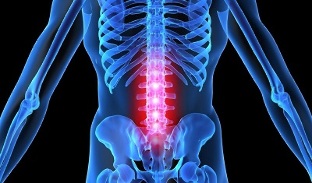
The lumbar region is located between the lumbar, sacrum and thoracic region and consists of five vertebrae connected by intervertebral discs.
The development of osteochondrosis means the wear and tear of the intervertebral discs, which act as a shock absorber during loading on the spine. The base of the discs is a gel-like mass protected by a dense fibrous ring and cartilage tissue, and the inner cavity is filled with a liquid nucleated pulposus.
As the loads on the vertebrae increase, the intervertebral discs lose their elasticity and resilience, height, and microcracks form in the annulus fibrosus, causing it to rupture and damage the nuclear pulp.
Tissue destruction is accompanied by compression of nerve roots on both sides of the vertebrae and causes severe pain.
The main symptoms of lumbar osteochondrosis:
- back pain;
- fatigue and depression;
- weakness or excessive muscle tension;
- loss of sensation in the surroundings, buddha or buddha;
- Acute or excruciating pains and spasms in the lower back, often radiating to the legs;
- motor dysfunction.
Against the background of severe lesions of the spine in the lumbar region, there are other symptoms, in most cases, dysfunction of other organs - the urinary and reproductive systems, gastrointestinal tract.
Causes
Like most diseases of the musculoskeletal system, osteochondrosis can develop for many reasons. Some roots come from lifestyle and diet, others develop against the background of physiological features of the body.
Often, treatment of lumbosacral osteochondrosis of the spine is required not only for constant force loads, but also for athletes with periodic injuries.
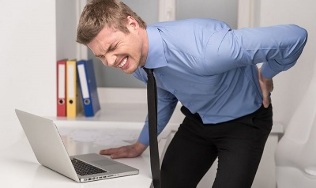
The second category of people at risk are people who spend most of their time in one position by profession - teachers, hairdressers, cooks, porters, waiters, programmers, office workers and drivers.
Other causes of pathological development include:
- overweight;
- metabolic disease;
- wrong posture, bending;
- genetic predisposition;
- injuries;
- bad habits;
- deficiency of useful trace elements and vitamins in the diet;
- Abnormal development of the musculoskeletal system, straight legs;
- hypothermia;
- inactivity, static;
- frequent stress.
All of these factors can affect the elasticity of the intervertebral discs, as they contribute to circulatory disorders or a lack of nutrients entering the spinal tissues.
The vertebrae can perform their functions subject to regular tissue renewal. In the case of any nourishment of the vertebral tissues, regeneration processes slow down or stop completely, whether it is a lack of blood circulation or metabolic problems. Thus, there is a dry and dystrophic change in the cartilage and fibrous ring of the spine.
Degrees of lumbar osteochondrosis
Depending on the level of the spinal lesion, there are four degrees of development of osteochondral processes that manifest themselves in stages as the disease progresses.
First degree
Pathological processes in the spine begin long before the first clinical manifestations. As a result of moisture loss, the intervertebral discs become less elastic. The height of the discs remains normal. The patient feels discomfort in the lumbar region.
Second degree
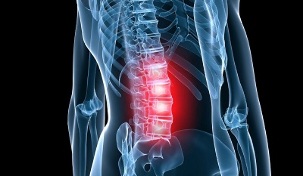
Against the background of lack of moisture, micro-cracks appear in the annulus fibrosus and tissue inflammation develops.
The processes of the vertebrae in the form of hooks gradually increase. Seals develop in the cartilage.
The patient complains of back pain that spreads to his legs or groin. It is possible to limit motor abilities. There are malfunctions in the internal organs.
Third degree
The integrity of the annulus fibrosis is compromised, the intervertebral disc protrudes and forms a hernia. Vessels and nerve endings are compressed. There are muscle spasms, dysfunction of the pelvic organs, sensory disturbances of the lower extremities, prolonged radiculitis attacks.
Fourth degree
The most difficult, untreated stage in the course of the disease. Complete destruction of the intervertebral discs results in scarring. The vertebra is as close as possible and gradually deforms. Paralysis of the lower extremities is possible with the development of spinal cord compression.
If timely treatment of lumbar osteochondrosis is not provided, the destruction of the spine progresses and can lead to disability.
Diagnostics
To recognize a disease and make an accurate diagnosis, neurologists use a number of measures - anamnesis, physiological examination and instrumental studies.
Anamnesis apple
Provides study of patient complaints:
- cause for concern;
- place of concern;
- duration and intensity of unpleasant feelings;
- duration of the disease;
- possible causes of the disease;
- ignition frequency;
- aggravating factors;
- Welfare-improving factors.
In addition, the doctor learns about the patient's lifestyle, diet, work and rest, the presence of harmful habits, hereditary factors and trauma.
Physiological examination
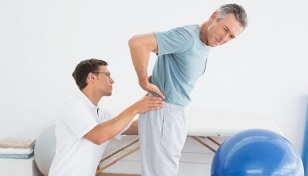
Performed to identify pathological changes and make an initial diagnosis.
During the examination, the doctor assesses the patient's motor abilities - gait, posture, amplitude and degree of movement. Palpation examines the condition of the muscles - tone, size, volume, the presence of spasms.
Determines the level of sensitivity with a slight tingling sensation. Hitting with a hammer makes it possible to recognize areas of pain radiation.
Hardware tests
Doctors use a variety of medical equipment to obtain complete and accurate information about the location of the pathology and the degree of tissue damage.
Radiography.X-ray examination of the lumbar region allows to determine the anatomical parameters of the vertebral and intervertebral discs, the tendency to narrow the gaps between the bottoms, the presence of bone growths.
Tomography.The use of electromagnetic waves provides an on-screen view of the area being studied to further study and analyze the condition of the vessels that supply spinal tissue, nerve processes, and intervertebral discs.
CT.X-rays of several segments of the spine are taken. The image is displayed on a monitor to determine the nature of changes in blood vessels, vertebrae and spinal cord membranes, and extraneous growths.
For differential diagnosis, various types of studies are performed to exclude pathologies of other body systems.
Treatment of lumbosacral spinal osteochondrosis
The duration and characteristics of treatment of lumbosacral osteochondrosis depend on the results of diagnostic measures. Conservative treatment is indicated in the early stages of the disease. Surgery is used for more complex lesions of the spine.
The optimal therapeutic effect is achieved through a complex therapy that includes the use of local drugs, physiotherapy, massage and health-promoting gymnastics.
Medication
Non-steroidal drugs are prescribed for internal and external use to relieve symptoms - tablets, injections, ointments. In addition, chondroprotectors, neuroprotectors, diuretics, vitamins, muscle relaxants are used.

The drug allows:
- relieve pain;
- eliminate inflammation;
- relax your muscles;
- restore damaged cartilage tissue;
- improve blood circulation;
- reduce swelling;
- increase physical activity;
- normalizes brain nutrition.
Novocaine blockade is used for acute pain, which provides immediate action.
Folk remedies
Traditional treatment is effective in addition to drug treatment. The main methods of traditional medicine are based on the use of plant materials, animal products and chemicals.
Ointments and compresses are made on the basis of various components, used for indoor and outdoor use, as well as for therapeutic baths.
Physiotherapy for lumbar osteochondrosis
Physiotherapy procedures are an excellent way to restore motor function of the spine after suffering from osteochondrosis.
The main methods of physiotherapy are:
- electrotherapy- exposure to weak electric currents to increase blood circulation in the tissues;
- magnetotherapy- use of magnetic field properties to restore tissue at the cellular level;
- laser therapy- complex activation of biological processes in spinal tissues and nerve endings;
- shock wave therapy- improvement of microcirculation and metabolic processes in affected tissues by exposure to acoustic waves;
- balneotherapy- to use the healing properties of mineral water.
Physiotherapy procedures not only increase the effectiveness of drug treatment several times, but also help to improve and strengthen the body as a whole.
Massage for osteochondrosis of the lumbar region
Visiting massage therapies is one of the most pleasant and effective ways to treat osteochondrosis.
With massage therapy:
- relieve muscle spasms;
- improve blood supply to affected areas;
- improve lymph flow;
- to restore atrophic muscles;
- Remove mobility restrictions.
Massage is prescribed when pain syndromes are eliminated.
Healing gymnastics
The main task of exercise therapy in osteochondrosis is to restore and correct the functionality of the spine. However, you can attend classes only after eliminating the symptoms of inflammation.
The most effective methods of medical gymnastics are:
- filling;
- visit to the gym;
- water therapy, swimming.
The hoop can be used for sports at home. Some doctors advise their patients to take yoga classes to restore the elasticity of the spine.
Exercises for aggravation of lumbar osteochondrosis
Any exercise for osteochondrosis should be done slowly and without sudden movements.
Appropriate exercises while lying on your stomach to strengthen the muscles that support the vertebrae. In this position, the arms are slightly stretched, but pulled up without tension. Repeat 4 times.
Surgery
The spine is treated with surgery, especially in difficult cases - with significant neurological disorders, as well as loss of control over the stool.
During the operation, the source of the disease is removed and measures are taken to stabilize the spine. The postoperative period lasts several months.
Why is lumbar osteochondrosis dangerous?
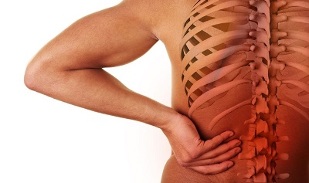
Degenerative changes in lumbar osteochondrosis contribute to the development of many life-threatening diseases. In the background of the intervertebral hernia are protrusions, lumbago and sciatica.
Further progression of the disease can lead to prolapse of the intervertebral disc and spinosis. In addition to the severe pain that accompanies the pathology, a person's motor skills are impaired to the point of complete loss. Paralysis of the lower extremities develops.
Death is inevitable in case of severe damage to the spinal cord.
Prevention
You need to pay attention to a healthy lifestyle to prevent destructive changes in the spine:
- doing sports - swimming, temperature;
- to follow a properly balanced, nutritious diet;
- eliminate bad habits;
- maintain posture;
- Support your spine while sleeping with an orthopedic mattress.
In addition, it is advisable to avoid hypothermia, heavy lifting. Women are advised not to wear high heels often.
If you adjust your lifestyle and remember the importance of physical activity, you can keep your back healthy.





































